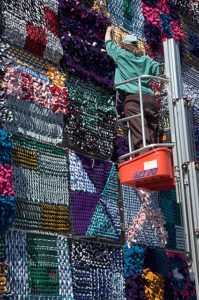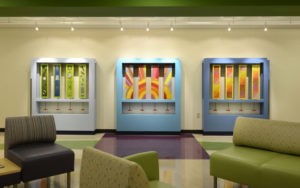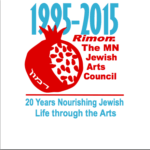With an MFA in Textile Arts and Costume Design from UC Davis, Katz-James is an artist extraordinaire—welder, fabricator, sculptor, weaver and assemblage artist. She was just awarded a 2016 Artist Initiative Grant from the Minnesota State Arts Board, which she is using to fabricate “Treasure Tower”, an outdoor metal sculpture that will be installed in downtown Mankato for one year starting in May 2016.
Katz-James has completed many public art pieces, planned and executed with the intention of being staged in the public domain, accessible to all.
I caught up with the artist to talk about her artwork and the joy she gets from creating art for the public sphere.
How did you become involved with public art?
When I moved to Minnesota, the first public art that I did was at the Minnetonka Center for the Arts in 2003. I was teaching silkscreen printing on fabric at the Center, and admired its giant outdoor courtyard, that featured a modern and dramatic wall. I had always wanted to make something really large and this wall was calling out to me. I am into recycling and repurposing, so I scrambled around for found and discarded materials that were free—polyester trim, fleece strips, giant needlepoint mesh, industrial felt. I figured out how to make a giant needlepoint grid and had a big event to install it using a cherry picker with volunteers stitching all the panels directly up on the wall. The work was displayed for six months, during which time it was open to the elements and gradually became covered in spider webs.
What do you enjoy about creating art for public spaces?
I am an extrovert and I love the idea that art is accessible to everyone and that we can work together and have a good time, but also learn something and create something together that then even more people can enjoy. Art that is out in the public realm, where you don’t have to enter a museum or know anything about art, is art you just stumble upon unexpectedly, and it offers a unique experience.
What is the typical process of creation for one of your art works?
In the beginning, I think of all my materials as my ingredients, like in cooking, and lay everything out—hardware, color palette, beads, found objects. Every piece begins in the welding studio with raw, gray, steel rods that I weld and bend to create structures. They then get painted and UV-coated. The structure then moves into the clean studio where the washers, beads and wire get applied. I enjoy the whole range of processes, from being in my work boots and making the rod to working with the colors to figure out the palette to prepping all the materials and sitting and assembling everything like a sewing or weaving project.
In what way does your Jewish identity inform your work? Tikkun Olam comes to mind, sharing your joy and creativity with the public as an act of kindness to repair a damaged world.
Yes, the joy, the play, an optimistic sense of discovery, I bring these into my work and then through my work onto the larger world. I also think about the act of taking small parts, discarded scraps, and making something valuable with them, something whole.
What are some pieces people can see now?
I have an interactive artwork on permanent display at the Children’s Hospital in St. Paul and the Children’s Hospital in Minneapolis. Getting my work to a kid who is sick, to a family member who is suffering through the ordeal of having a child in hospital, knowing they can experience my piece and have fun for a few minutes by interacting with the artwork is extremely rewarding.





